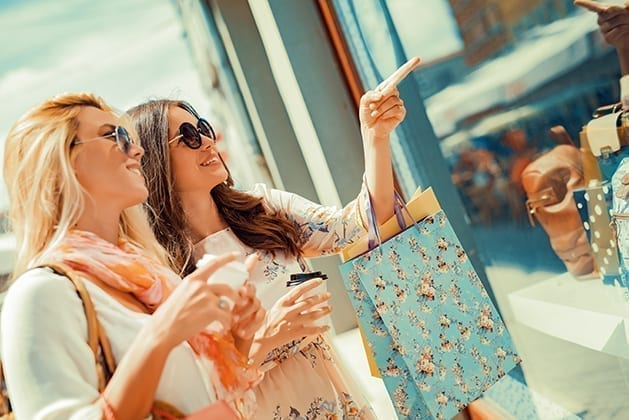
Boost your sales with cool customer experiences
Out of kitty litter? Need a new pair of shoes? With the click of a button, any grocery staples you notice are running low, or items you have been eyeing for weeks will conveniently show up on your doorstep, and all you have to do is log-on and order from your living room couch… ideally in your sweatpants.
The ease of online shopping is incredibly appealing for most, but as the shift to online retailing has increased, and the number of shopping options at your fingertips expands the younger generations trust it less. Disillusioned by fake merchandise and digital advertisements, Gen Z’ers, and even some Millennials are reverting to brick and mortar locations for a customized shopping experience.
Increasingly influenced by “influencers” and shopping local, the young consumers are seeking quality goods that they can look at and feel, before making the purchasing decision. So, what does that mean if you are an online-only retailer? It’s time to think about the physical space and the increasingly cool customer experiences retailers are using to entice their customers.
Make it personal
Everybody knows customers love personalization. Personalization doesn’t just mean coffee mugs with their initials on it anymore; it’s the idea that you can make their interaction with your brand something totally unique. Making their shopping experience custom is getting easier and easier as technological advances become readily available, and for a relatively inexpensive investment.
… they are even eager to give you personal information if that means an additional benefit for them. Making the customer feel like they are receiving a totally unique and hand-picked experience in your store will establish trust and keep them coming back for more.
Fact: Customer loyalty programs are favored by the Generation Z customer base. 75% of customers are more likely to buy from a retailer that personalizes their shopping experience. (Evergage)
Enter: the ‘groceraunt’
“At Kitchen 1883, we strive to create and deliver a genuine, guest-first experience through our food, Our ‘New American Comfort’ menu is a melting pot of American and international flavors. Kitchen1883 is about the community and the foods they love. It’s about gathering to celebrate life over food that speaks to the soul.”
-The Kroger Co.
The ‘groceraunt,’ a term stemming from the blending of a grocery store and a restaurant, is just y stores are upping the ante with customer experience. The groceraunt concept is a welcome addition to the grocery bars and tasting rooms, tea houses, and upscale beauty isles.
Even online retail giant, Amazon, has made concerted efforts into brick-and-mortar,
launching their flagship bookstore in Seattle back in August 2017, and its’ newly announced popup bar in Tokyo to promote their foray into liquor sales.
Only two things are certain in life: lattes and taxes
Grocery stores aren’t the only ones getting in on the shopper experience game, the customized experience is easily adaptable into most any retail environment, including service retail.
Tax season is a stressful time for most people. The fear of messing up and costing your family money can drive people to seek out tax service help last minute. What if you could make the filing process enjoyable? Kick back in a coffee house like setting while having tax consultants available when you have questions. If only H&R Block had couches and espresso shots.
So… Where to begin? 21% of KRS’ retail design clientele in 2017 came from non-traditional retail industries including service retail, universities, and medical offices.
Change begins within
Whether you are making the jump from online to brick and mortar or looking to refresh to stay relevant. Not getting lost in the fold of being just another brick and mortar retailer is a serious concern. People are more-and-more plugged into technology and are expecting cool features and surprising gimmicks in traditional retail stores, along with the service and quality you just can’t get from a screen. It sounds like they are asking a lot, but digging deep, and a little investment, can go a long way.
Defining your place in the retail space always begins with your brand. Indicating, and locating, those bits of differentiators that will set you apart from the sea of others offering the same goods and/or services is number one. You want your most important brand elements front and center.
Identifying your target demographic, and if you’ve had a presence for a while (whether online or physical), learning from your customers will provide you with invaluable suggestions on how to enhance their interaction with your brand.
Analyze your customer feedback and represent it physically. Work closely with your team on figuring out the tough questions:
- Are we trying to evoke a feeling from our customers?
- How are we going to place our staff?
- Is there a certain attitude to be conveyed?
These questions are especially important coming from an online space where there has been no human interaction with your customers before.
Why are we even talking about brick and mortar, isn’t it going away? How are we going to survive?
Becoming Cher
Jimmy James once quipped, “After a nuclear holocaust, all that will be left are cockroaches and Cher.” This retail apocalypse may never come, and if it does- it’s survival of the fittest, and Cher has always been pretty darn fit. For now, brick and mortar is not dead, or even dying for that matter. However, the competitive nature of retail is growing stronger and becoming a beast that cannot be tamed. How will you survive the ever-changing retail landscape? Be smart, modernize and adapt… become Cher.
King Retail Solutions
KRS has been providing award-winning retail store design, manufacturing, distribution, and each of these service areas, we are recognized as industry leaders.
For more information on how KRS can help you connect with your customer, make a lasting impression, boost brand image and drive sales, contact us today.
Summary
As online shopping grows, younger generations are seeking personalized and tangible experiences in physical retail spaces. Retailers are responding with creative approaches like 'groceraunts,' interactive tasting bars, and experiential stores to engage customers. Success in brick-and-mortar requires aligning the store with the brand, understanding customer preferences, and crafting an emotional and memorable shopping experience that can’t be replicated online.
Key Takeaways
- Consumers, especially Gen Z and Millennials, increasingly value physical interaction with products and personalized shopping experiences.
- Personalization extends beyond merchandise to creating unique, hand-picked experiences for customers, which builds loyalty.
- The 'groceraunt' concept blends grocery and restaurant experiences to enhance engagement and community connection.
- Even online giants like Amazon are embracing brick-and-mortar spaces to provide experiential retail opportunities.
- Experiential retail can be adapted to non-traditional industries, including service-based businesses, universities, and medical offices.
- Successful physical retail requires aligning the store design, staff, and customer interaction with the brand’s values and differentiators.
- Analyzing customer feedback and responding with intentional design and service strategies is critical for a meaningful in-store experience.
- Brick-and-mortar retail is not dying; it is evolving, and businesses that modernize and adapt creatively will thrive.
Frequently Asked Questions
Q. Why is a physical retail space still important in the age of online shopping?
A. Younger consumers value the ability to see, touch, and try products in person. Physical spaces allow brands to offer personalized, memorable experiences that can’t be replicated online.
Q. What is a 'groceraunt'?
A. A 'groceraunt' blends a grocery store with a restaurant, offering scratch-made menus, tasting bars, or curated food experiences that enhance customer engagement.
Q. How can retailers personalize the shopping experience?
A. By creating unique, hand-picked experiences, leveraging technology for customized interactions, and using loyalty programs to reward individual customer preferences.
Q. Can experiential retail work outside of traditional stores?
A. Yes. Non-traditional sectors like service retail, universities, and medical offices can implement engaging, personalized experiences to connect with customers or clients physically.
Q. What is the first step to creating a successful customer experience in-store?
A. It begins with the brand: defining its differentiators, identifying the target demographic, analyzing customer feedback, and translating those insights into a physical, engaging, and emotionally resonant store experience.
